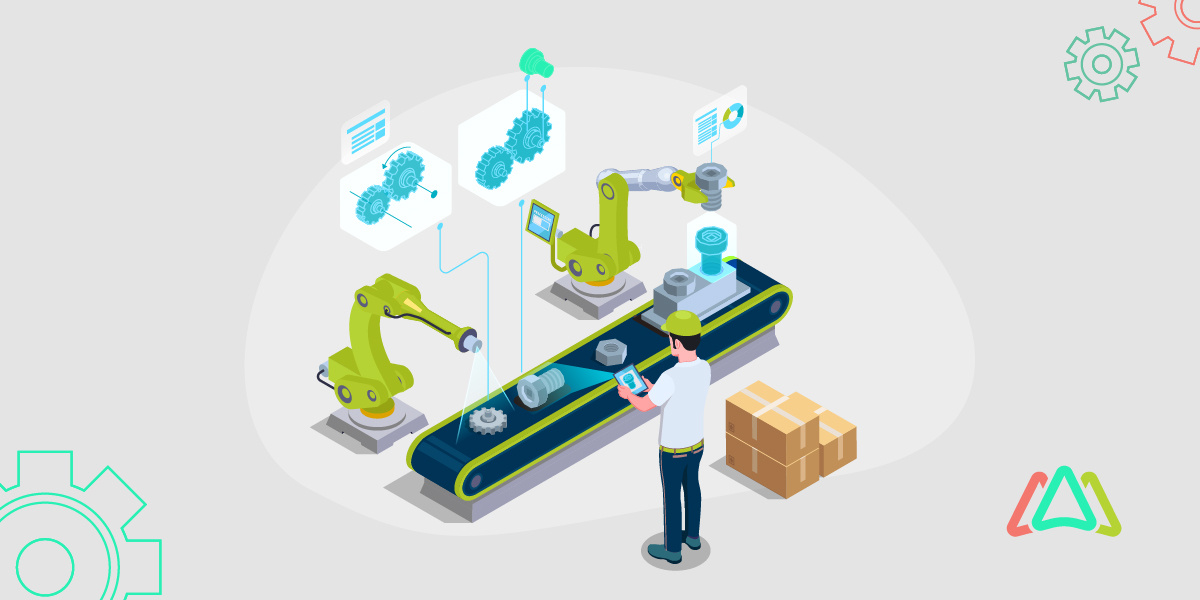
Overcoming CMMS IoT Integration Challenges
Imagine a world where your maintenance team predicts machine failures before they occur, seamlessly schedules repairs, and keeps operations running like clockwork—all without lifting a finger. This is the transformative promise of integrating the Internet of Things (IoT) with a Computerized Maintenance Management System (CMMS). By feeding real-time performance data from IoT sensors directly into the CMMS, maintenance evolves from reactive or even preventative to predictive, precise, and proactive.
But here’s the challenge: while the vision is compelling, the reality of IoT-CMMS integration is anything but straightforward. Many organizations struggle with compatibility issues, data security concerns, and the sheer complexity of implementation, making this promising vision challenging.
Yet, the potential benefits are too significant to overlook. The global Industrial IoT (IIoT) market is projected to reach an astounding $1.11 trillion by 2028. In this article, we’ll dive into the most common challenges businesses face in IoT-CMMS integration and, more importantly, offer practical solutions to overcome them. If you’re ready to unlock the full potential of smart, connected maintenance, let’s get started.

CMMS and IoT Explained - A Brief Overview
A Computerized Maintenance Management System (CMMS Software) is software designed to streamline maintenance operations. Its core functionalities include asset management, scheduling preventive maintenance, tracking work orders, and generating insightful reports to improve efficiency and reduce downtime.
The Internet of Things (IoT) refers to a network of connected devices that collect and exchange real-time data. In maintenance, IoT devices like sensors provide critical insights, such as equipment performance and environmental conditions, enabling predictive analytics.
Integrating CMMS with IoT creates a powerful synergy. IoT devices supply real-time data directly to the CMMS, enabling predictive maintenance and minimizing unexpected failures. This integration automates workflows, enhances decision-making, and improves asset health monitoring, giving businesses a smarter, more efficient approach to maintenance management. Together, CMMS and IoT revolutionize maintenance by combining actionable data with streamlined execution.
Challenges in CMMS and IoT Integration
Integrating IoT with CMMS presents challenges such as compatibility issues, data overload, security risks, high costs, and skill gaps. These hurdles can hinder seamless adoption, affecting operational efficiency. Addressing these CMMS and IoT integration challenges is important for businesses aiming to leverage IoT-powered maintenance systems effectively.
Compatibility and Interoperability Issues
Legacy CMMS systems often struggle to connect with IoT devices due to outdated architecture. The lack of standardized communication protocols complicates integration, while conflicts with existing software ecosystems create additional barriers to achieving a fully connected maintenance environment. Overcoming these issues is key to maximizing IoT-driven efficiency.
Data Overload and Management
The integration of IoT with CMMS generates massive data volumes, making it challenging to process and analyze effectively. Data redundancy and inconsistencies can lead to inefficiencies, while a lack of real-time synchronization between IoT devices and CMMS hinders timely decision-making and maintenance optimization.
Security and Privacy Concerns
Integrating IoT with CMMS exposes systems to risks, such as data breaches during transmission and vulnerabilities in IoT devices. Ensuring compliance with data protection regulations, such as GDPR and CCPA, adds complexity, making robust cybersecurity measures essential to protecting sensitive maintenance and operational data.
High Implementation Costs
Integrating IoT with CMMS involves significant expenses, including the purchase of IoT-enabled devices and sensors, customization of CMMS software, and ongoing maintenance and updates. These high costs can be a barrier for businesses, particularly small to medium-sized enterprises, limiting their ability to adopt IoT-powered maintenance solutions.
Skill Gap and Resistance to Change
Many organizations lack in-house expertise in IoT and CMMS integration. Maintenance teams may resist adoption due to steep learning curves, and training employees to manage the integrated systems effectively poses additional challenges. These slow down implementation and reduce the potential benefits of IoT-enabled maintenance solutions.
Scalability and System Upgrades
Scaling IoT-integrated CMMS systems for growing operations can be challenging. Upgrading IoT hardware and CMMS software without causing workflow disruptions adds complexity. Ensuring the system remains adaptable and future-ready while maintaining seamless operations requires careful planning and significant investment, especially for rapidly evolving industries.
How to Overcome CMMS IoT Integration Challenges
To overcome CMMS IoT integration challenges, businesses should prioritize selecting compatible devices, standardizing communication protocols, and ensuring real-time data synchronization. Investing in cybersecurity measures, offering employee training, and planning for scalable solutions can reduce resistance and costs. Regular updates and strong vendor support help maintain smooth operations.
Choosing the Right CMMS and IoT Solution
Invest in IoT-compatible CMMS platforms with strong but easy API integrations to ensure seamless communication. Consider modular systems that can easily scale as IoT capabilities expand, allowing for future-proof solutions. This approach ensures long-term efficiency and adaptability, making it easier to integrate new devices and technologies.
Ensuring Data Management Best Practices
Utilize centralized cloud-based systems for efficient data storage and analysis, ensuring easy access and real-time updates. Implement data cleansing and deduplication processes to maintain data accuracy, reduce redundancy, and improve decision-making. These best practices enhance the reliability and efficiency of IoT and CMMS integration.
Strengthening Cybersecurity Measures
Implement encrypted communication protocols between IoT devices and CMMS to secure data transmission. Update firmware and software regularly to fix vulnerabilities and use role-based access controls to limit unauthorized access. These measures ensure robust security, protect sensitive maintenance data and minimize the risk of cyber threats.
Addressing the Skill Gap
Invest in comprehensive employee training programs for IoT and CMMS operations to build internal expertise. Collaborate with solution providers for ongoing support and training. Create multidisciplinary teams that combine IT and maintenance knowledge, ensuring smooth integration and effective management of IoT-powered CMMS systems across the organization.
Planning for Long-Term Scalability
Opt for scalable IoT devices and cloud-based CMMS solutions that grow with your operations. Regularly assess system performance to identify potential upgrades, ensuring seamless expansion. This proactive approach ensures your system remains adaptable, efficient, and ready to meet future demands without disrupting ongoing maintenance processes.

The Future of CMMS and IoT Integration
The integration of CMMS and IoT is poised for a technological revolution, with emerging trends set to redefine maintenance operations. These advancements promise to move businesses closer to fully autonomous and intelligent maintenance practices, driving efficiency, sustainability, and cost savings.
AI-Powered Analytics for Enhanced Predictive Maintenance
Artificial intelligence (AI) is becoming a cornerstone of CMMS and IoT integration. By analyzing vast volumes of real-time data from IoT sensors, AI enhances predictive maintenance capabilities, allowing systems to forecast equipment failures with unprecedented accuracy. Beyond prediction, AI can autonomously optimize maintenance schedules, ensuring resources are allocated efficiently, and downtime is minimized.
Edge Computing for Faster Decision-Making
Edge computing is transforming how IoT data is processed. By performing computations closer to the source, such as IoT devices or sensors, latency is significantly reduced. This approach is particularly valuable in remote or bandwidth-limited environments, enabling quicker, localized decision-making and improving system responsiveness.
The Rise of Digital Twins
Digital twins, virtual replicas of physical assets, are poised to revolutionize maintenance management. These simulations provide real-time insights into asset performance, enabling businesses to predict and address issues before they escalate. By combining digital twins with IoT and CMMS, companies can transition to a more proactive and strategic approach to maintenance.
Cloud Computing and 5G Networks
The integration of cloud computing and 5G technology is set to revolutionize connectivity in IoT-enabled CMMS systems. Cloud computing enhances scalability and data accessibility, while 5G’s high-speed, low-latency connectivity ensures seamless communication between IoT devices and CMMS platforms. Together, these technologies enable real-time data sharing and pave the way for more integrated and intelligent maintenance ecosystems.
Sustainability Through Smart Maintenance
With a growing emphasis on environmental sustainability, IoT and CMMS integration will drive smarter resource utilization. Predictive maintenance minimizes unnecessary repairs, reduces energy consumption, and extends asset lifespans, contributing to more sustainable operations. These practices align with broader business goals of reducing carbon footprints and enhancing operational efficiency.
A Glimpse Into the Next Decade
In the coming years, IoT and CMMS integration will become increasingly seamless, with systems evolving to support fully automated, intelligent maintenance operations. Businesses will rely on real-time data to enable autonomous decision-making, transforming maintenance from a reactive or even predictive process to a dynamic, self-optimizing system. As these technologies mature, they will unlock new levels of efficiency and reliability while reducing costs and promoting sustainable practices.
Conclusion
Integrating CMMS and IoT offers tremendous potential for enhancing maintenance efficiency. However, it also comes with challenges such as compatibility issues, data overload, security concerns, and high costs. Overcoming these challenges is obligatory for businesses aiming to stay competitive and optimize maintenance operations.
However, with the right strategy, tools, and expert guidance, the integration process can be seamless. By selecting the right CMMS and IoT solutions, implementing data management best practices, and prioritizing cybersecurity, businesses can unlock the full potential of this integration.
We encourage businesses to take the first step by assessing their current systems and identifying gaps in compatibility, data management, or security. Consulting with experts can provide tailored solutions that pave the way for a successful CMMS IoT integration, ultimately leading to smarter, more efficient maintenance practices. The future of maintenance is here—embrace it for lasting success.
TABLE OF CONTENTS
Keep Reading
Ever find yourself checking into a luxury hotel and expecting a relaxing stay, only to find a ...
11 Apr 2025
Organizations are witnessing swift changes in the business environment and confronting a ...
8 Apr 2025
Last month, news outlets and the entire internet was abuzz with the return of NASA astronauts ...
3 Apr 2025
What comes first - CMMS or predictive maintenance? If your answer is either, it is correct. ...
28 Mar 2025
Artificial intelligence (AI) talk has become commonplace. Today, engaging in business-focused ...
27 Mar 2025
Imagine a world where machines predict, diagnose, and fix their issues before they fail. This ...
25 Mar 2025
A facility maintenance plan is at the core of a facility’s operations. This organized ...
21 Mar 2025
Think of managing your maintenance operations like managing a championship sports team. Just ...
21 Mar 2025
The maintenance sector is battling a severe talent shortage that threatens to undermine ...
7 Mar 2025
Manufacturing maintenance is the backbone of industrial efficiency, ensuring machines run ...
5 Mar 2025
No one likes playing a guessing game when equipment breaks down. Yet, maintenance teams often ...
4 Mar 2025
The size of the preventive maintenance software market is discussed in millions of dollars, ...
4 Mar 2025
The organizational structure and corporate hierarchy vary from company to company. Large ...
28 Feb 2025
Maintenance procedures are essential for ensuring the longevity and reliability of machinery ...
21 Feb 2025
Sustainability is no longer just a buzzword; it's a critical component of corporate social ...
20 Feb 2025
A Computerized Maintenance Management System (CMMS) relies on accurate, well-organized data ...
18 Feb 2025
In an era where technology drives operational efficiency, Computerized Maintenance Management ...
14 Feb 2025
A Computerized Maintenance Management System (CMMS) is a key component of modern maintenance ...
13 Feb 2025
Introduction Maintenance management is the foundation of maintenance operations in industries ...
11 Feb 2025
Introduction A Computerized Maintenance Management System (CMMS) is software designed to help ...
7 Feb 2025





